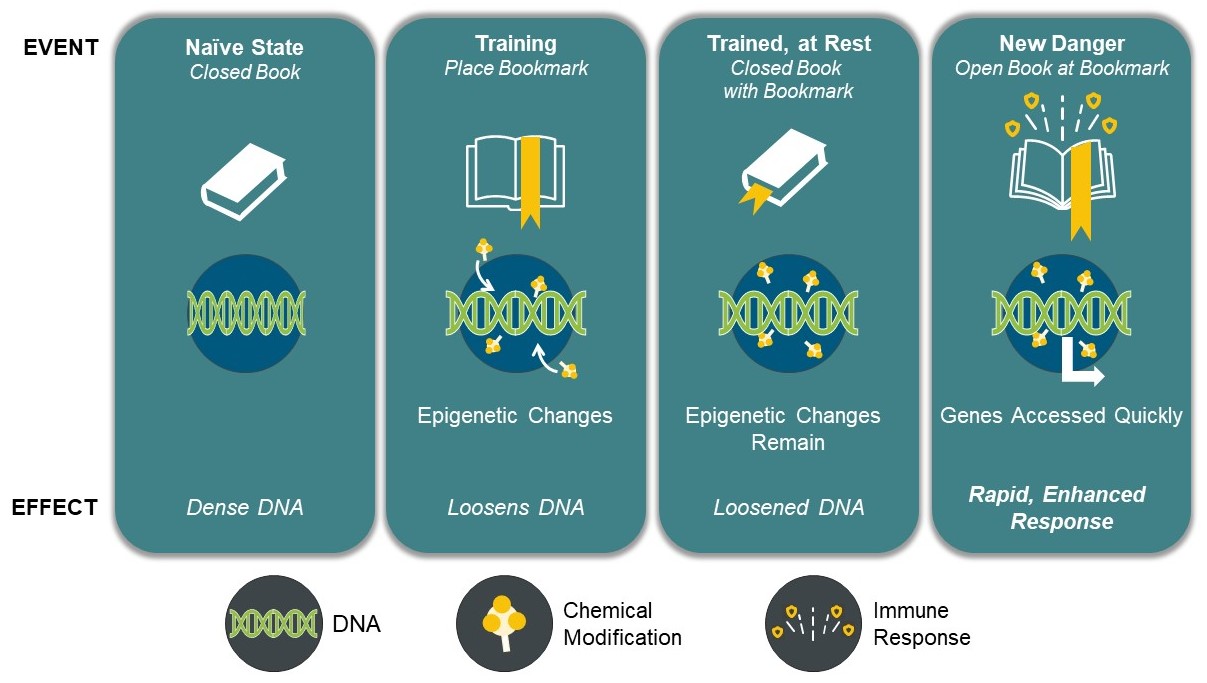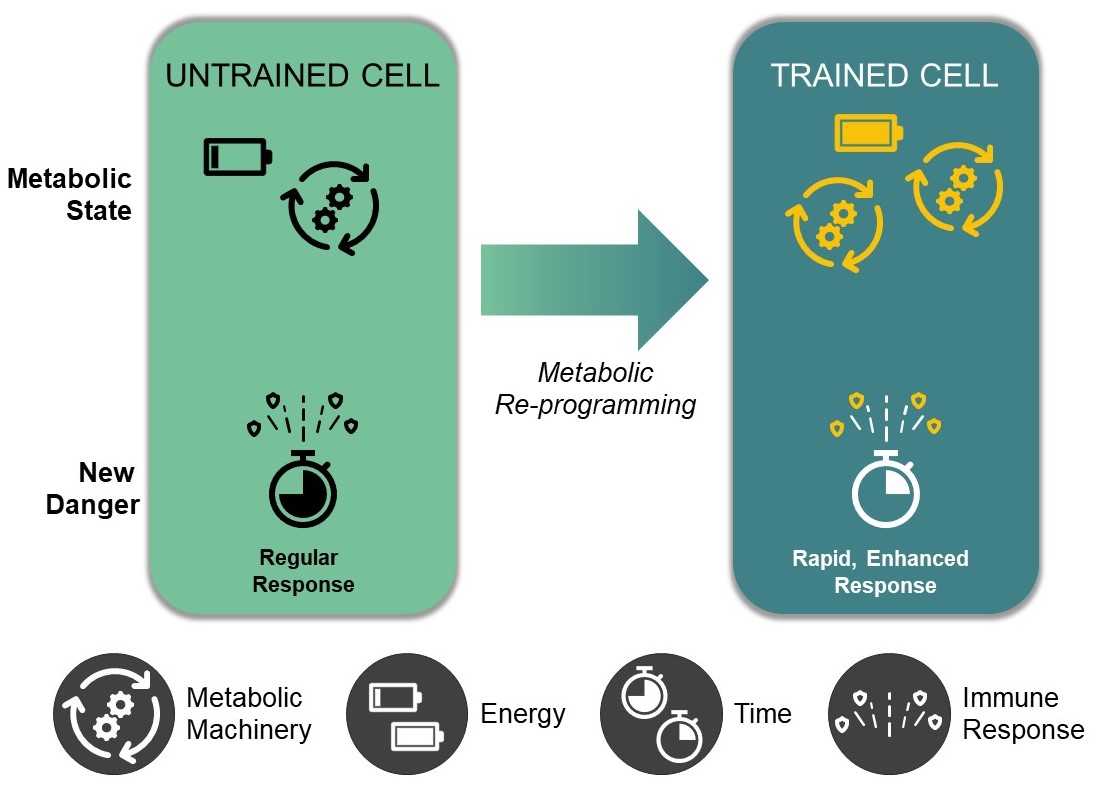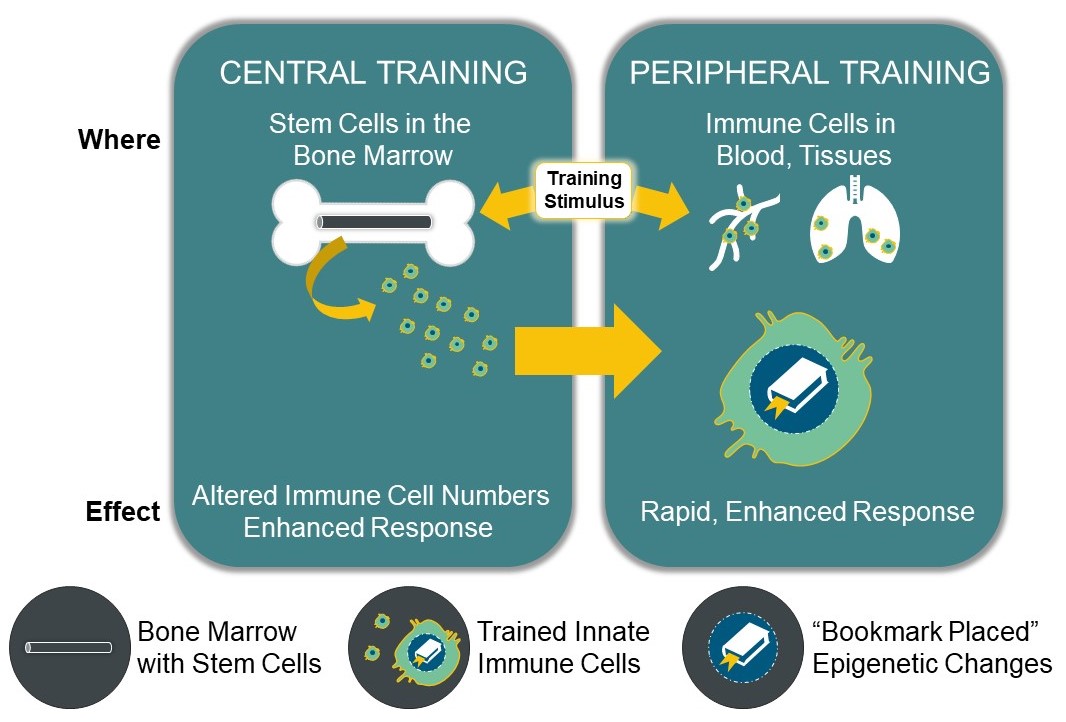Almost 100 years ago when childhood mortality due to infectious disease was high, Dr. Carl Naslund noticed a curious thing – Swedish children that had received a tuberculosis vaccine not only were protected from tuberculosis but were three times less likely to succumb to any disease compared to the children who weren’t vaccinated. Decades later, this observation was noticed again, where vaccinated children in high-mortality areas of West Africa had a significantly lower mortality rate (Garly, et al., 2003). In 2012, the mystery behind these observations was finally solved and a new type of immune protection was identified, now called trained immunity (Kleinnijenhuis, et al., 2012).
The understanding of immune memory has been centered around the idea of targeted, disease-specific approaches. The aim of a vaccine is to induce this disease specific memory in your adaptive immune system (memory T and B cells), which then can spring into action if an individual is exposed to that disease. However, trained immunity research has been ground-breaking within the field of immunology due to its differences in immune memory. It revealed that cells of the innate immune system also have a kind of memory, although this memory works in a very different way and results in defense against a broad range of threats. With the discovery of trained immunity, we now know that it is possible to also increase protection against multiple, unrelated diseases. This important discovery has therefore presented new opportunities to bolster immune defenses against a myriad of threats in a non-targeted manner; a new method to protect ourselves from future disease. Moreover, research has recently shown that it is possible to induce trained immunity through food (Horneck Johnston, et al., 2024).

How Does Innate Training Occur?
A growing body of research over the past decade has helped identify key mechanisms which explain how innate training occurs. Innate training agents, such as the BCG vaccine (Kleinnijenhuis, et al., 2012) and the adenoviral ChAdOx1 nCoV-19 vaccine (Murphy, et al., 2023) are able to induce trained immunity via metabolic reprogramming and epigenetic modifications (Domínguez-Andrés, et al., 2019).
Epigenetic Changes – Placing a Bookmark
DNA contains instructions for making proteins, including proteins crucial for launching immune responses. However, DNA is a very tightly coiled structure where gaining access to the instructions required can take precious time. One can think of it as DNA being a large and heavy instruction manual, with thousands of pages, where finding the correct page will take time. Training stimuli, such as the BCG vaccine, in essence creates bookmarks in this instruction manual to be placed on crucial pages for launching immune responses. This act of “placing the bookmark” is done via epigenetic changes; reversible chemical modifications to the DNA structure that loosen the DNA at certain sites, making the genes/instructions at those sites more easily accessible. These epigenetic changes are made possible due to altered metabolism within the cell, which provides the materials for these chemical modifications to occur. The result: when a subsequent danger is detected in future, the relevant pages/genes are more easily read, allowing an immune response that is more rapid and potent, compared with non-trained immune cells. This more potent response is also possible due to metabolic reprogramming.

Placing the bookmark: Innate trainers place bookmarks in the DNA instruction manual; metabolic reprogramming provides the building blocks for chemical modifications (bookmarks) to occur on the DNA – epigenetic changes – resulting in loosened DNA, ready to be read when a new potential danger occurs. Adapted from “Mihai Netea and Niels Riksen at ImmunoMetNet’s Seminar – The double-edged sword of trained immunity” – https://www.youtube.com/watch?v=5AWnp5cEw_4
Metabolic Reprogramming – Meeting Energy Requirements
When an immune cell is activated as part of launching an immune response, processes engage which require a lot of energy and the production of numerous compounds, such as immune messenger signals. These energy and production demands are met by metabolic machinery. Innate training stimuli initiate metabolic reprogramming, which not only provides the necessary building blocks for epigenetic changes to occur to the DNA (“placing the bookmark”), but importantly also increases the metabolic machinery available to the cell, to meet future energy and production requirements. This could be seen as the trained cell building up its energy infrastructure to be better prepared for future challenges. When a subsequent danger is detected, the innate immune cells can immediately spring into action, as this enhanced metabolic machinery is ready to meet the required energy and production needs, facilitating a rapid and robust immune response (Fanucchi, et al., 2021).

Is Trained Immunity Long Lasting?
A hallmark of the adaptive immune response is the induction of long-lived memory cells, which mobilize should a “memorized” danger appear again. This is the type of memory targeted with a vaccine, to induce long-lived protection. Trained immunity has also been shown to last for several months, despite innate immune cells not living for very long. Innate immune cells are replaced regularly, both by cell division and by influx of new cells, coming from hematopoietic stem cells in bone marrow. These stem cells divide and mature into different types of immune cells, replenishing the body’s immune cells as needed. The explanation of innate training above has focused on individual innate immune cells coming across training stimuli and thus having a more efficient responses against subsequent dangers. This type of trained immunity is known as peripheral trained immunity, and is thought to be maintained, at least to a degree, by cell division – where epigenetic modifications (bookmarks) can be passed on to daughter cells (Kachroo & Robin, 2013). Although this is believed to contribute to the longevity of trained immunity, the core component is due to training of hematopoietic stem cells in the bone marrow, as identified by epigenetic changes therein. This is known as central trained immunity (Ochando, et al., 2023). How this training occurs is not fully understood, although certain immune messenger signals have been identified to contribute to this phenomenon. It has also been postulated that stem cells may be able to detect danger signals, in a similar manner as innate immune cells, possibly leading to similar metabolic and epigenetic outcomes. Because stem cells divide and become lots of different immune cells, their training can result in altered amounts of certain immune cells, as well as affect their responses. For instance, central trained immunity induced by BCG vaccination, has been shown to result in a higher number of innate immune cells that are more effective at fighting off infections up to five months post vaccination, due to altered gene expression (Kaufmann, et al., 2018).

Although studies have shown that innate training can be long lasting, there is an important aspect of this phenomenon that needs to be highlighted: it is reversible. Epigenetic changes, placing bookmarks at relevant pages, are a core component of trained immunity, which are caused by chemical modification to the DNA. However, these modifications can be reversed, and the bookmarks consequently removed (Chen & Natarajan, 2022) (Arzola-Martínez, et al., 2023). This is a highly dynamic feedback system, where the innate immune response is adapting to new information all the time.
Can You Train Your Immune Response?
There are numerous substances and challenges that have been shown to cause trained immunity, such as the earlier mentioned BCG and adenovirus COVID-19 vaccines, and more are being discovered all the time. However, most identified innate trainers need to be either administered by medical staff or occur as the result of an infection/being sick, neither of which is ideal for day-to-day protection. To both induce trained immunity and maintain it, the most desirable approach is something an individual can eat or drink. Fortunately, research suggests that certain functional/bioactive ingredients found in everyday food, beverages and dietary supplements may be able to induce and maintain this process of trained immunity. For instance, research recently published by Prof Fred Sheedy (Horneck Johnston, et al., 2024), has demonstrated this possibility: food-safe whole beta glucan particles (WGPs) were demonstrated to not only induce trained immunity in isolated innate immune cells (peripheral trained immunity) but also resulted in central trained immunity when ingested by mice. This discovery has opened new dietary possibilities to bolster defenses against immune challenges.
To conclude, for support of everyday health, there is enthusiastic interest/focus on the influence of diet and supplementation to aid the immune system. These approaches include the use of probiotics to support balanced gut flora and the inclusion of essential nutrients, such as vitamin C, to maintain regular immune function. What is exciting about the discovery of trained immunity, and the possibility to induce it through diet, is that enables next level immune protection. As discussed herein, it is a recently discovered, natural enhancement of the innate immune defense, enabling the immune system to be at the ready for future challenges.
-
Dr. Mimmi Lundahl, PhD

Dr. Mimmi Lundahl is an Immunology Scientist, working for (RDA) ProActive Health at Kerry. Her research focuses primarily on how functional ingredients interact with the innate immune system. She has a Molecular Biology degree from Lund University in Sweden, a M.Sc. in Immunology and a PhD in Immunology and Chemistry from Trinity College Dublin, Ireland.
-
References
Aaby, P. & Benn, C. S., 2012. Saving lives by training innate immunity with bacille Calmette- Guérin vaccine. Proceedings of the National Academy of Sciences of the United States of America, 109(43).
Arzola-Martínez, L., Ptaschinski, C. & Lukacs, N. W., 2023. Trained innate immunity, epigenetics, and food allergy. Frontiers in Allergy, Volume 4.
Chen, Z. & Natarajan, R., 2022. Epigenetic modifications in metabolic memory: What are the memories, and can we erase them?. American Journal of Physiology – Cell Physiology, 323(2).
Domínguez-Andrés, J., Joosten, L. A. B. & Netea, M. G., 2019. Induction of innate immune memory: the role of cellular metabolism. Current Opinion in Immunology, Volume 56.
Fanucchi, S. et al., 2021. The Intersection of Epigenetics and Metabolism in Trained Immunity. Immunity, 54(1).
Garly, M. L. et al., 2003. BCG scar and positive tuberculin reaction associated with reduced child mortality in West Africa: A non-specific beneficial effect of BCG?. Vaccine, 21(21-22).
Horneck Johnston, C. J. H. et al., 2024. Recognition of yeast β-glucan particles triggers immunometabolic signalling required for trained immunity. iScience.
Kachroo, A. & Robin, G. P., 2013. Systemic signaling during plant defense. Current Opinion in Plant Biology, 16(4).
Kaufmann, E. et al., 2018. BCG Educates Hematopoietic Stem Cells to Generate Protective Innate Immunity against Tuberculosis. Cell, 172(1-2), pp. 176-190.e19.
Kleinnijenhuis, J. et al., 2012. Bacille Calmette-Guérin induces NOD2-dependent nonspecific protection from reinfection via epigenetic reprogramming of monocytes. Proceedings of the National Academy of Sciences of the United States of America, 109(43).
Murphy, D. M. et al., 2023. Trained immunity is induced in humans after immunization with an adenoviral vector COVID-19 vaccine. Journal of Clinical Investigation, 133(2).
Ochando, J. et al., 2023. Trained immunity — basic concepts and contributions to immunopathology. Nature Reviews Nephrology, 19(1).



